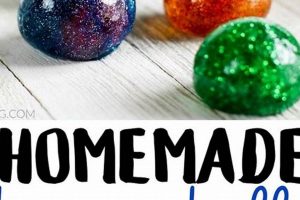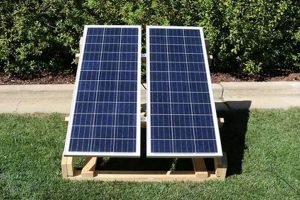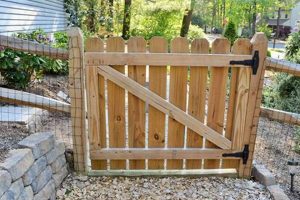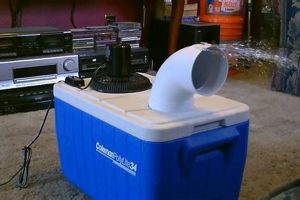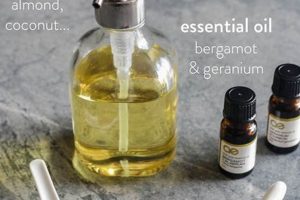A self-constructed water feature designed to attract avian wildlife, typically shallow and providing a source of potable water for drinking and bathing, further enhanced with a recirculating water system for aesthetic appeal and increased attraction. Such a project might involve repurposing existing containers, integrating a small submersible pump, and arranging decorative elements to create a visually pleasing and functional environment for birds.
Offering a dependable water source benefits local bird populations, particularly during dry periods or in urban environments where natural water sources are scarce. The movement of the water, often achieved with a pump, helps to prevent stagnation and algae growth, contributing to a healthier environment for the birds. Historically, bird baths have served both practical and ornamental purposes in gardens and landscapes, reflecting a longstanding appreciation for avian species and their role in the ecosystem.
Subsequent sections will delve into various construction methods, material selection considerations, pump specifications, and best practices for maintaining the resulting avian-friendly water feature. These details will enable individuals to undertake this project with a thorough understanding of the requirements and potential outcomes.
Essential Guidelines for Constructing an Avian Water Feature
Effective planning and execution are crucial for creating a safe and appealing environment for birds. The following guidelines provide a framework for successful design, construction, and maintenance.
Tip 1: Location Assessment: Prior to construction, evaluate potential locations. Factors to consider include proximity to trees (potential for droppings), visibility from indoors (for observation), and exposure to sunlight (algae growth potential).
Tip 2: Material Selection: Opt for non-toxic materials that are easy to clean and resistant to weathering. Concrete, glazed ceramic, or durable plastic are suitable choices. Avoid materials that could leach harmful chemicals into the water.
Tip 3: Shallow Basin Design: Ensure the water depth is no more than two to three inches. This prevents accidental drowning, especially for smaller bird species. Gradual slopes allow birds of different sizes to use the feature comfortably.
Tip 4: Water Circulation System: A small submersible pump is essential for maintaining water quality and preventing mosquito breeding. Choose a pump with adjustable flow to control the water movement and prevent excessive splashing.
Tip 5: Regular Cleaning Protocol: Implement a cleaning schedule to remove debris, algae, and bird droppings. Regular cleaning minimizes the risk of disease transmission and maintains the feature’s aesthetic appeal. Use a stiff brush and diluted vinegar solution for effective cleaning.
Tip 6: Winterization Measures: In colder climates, take steps to prevent freezing. Consider using a bird bath heater or removing the feature entirely to prevent damage from ice expansion. Regularly check the water temperature during freezing temperatures.
Tip 7: Predatory Animal Deterrents: If predatory animals, such as cats, are common in the area, consider adding barriers or placing the feature in an open area where birds can easily spot approaching threats.
By adhering to these guidelines, the resulting structure will serve as a valuable resource for local bird populations while providing an attractive and functional element in the landscape. This approach contributes to both environmental stewardship and personal enjoyment.
The next section will explore common challenges encountered during construction and offer solutions to ensure a successful project outcome.
1. Basin Material Selection
The selection of appropriate materials for the basin is paramount in the construction of a functional and sustainable water feature for avian wildlife. Material properties directly influence water quality, longevity of the structure, and overall safety for the birds utilizing it. Thoughtful consideration of these factors is essential for a successful project.
- Toxicity and Water Quality
Certain materials can leach harmful chemicals into the water, posing a direct threat to bird health. Untreated metals, for example, may corrode and release toxins. Non-toxic materials, such as glazed ceramic, high-density polyethylene (HDPE), or sealed concrete, are preferred to prevent water contamination and ensure the safety of avian users.
- Durability and Weather Resistance
The basin is continuously exposed to the elements, including fluctuating temperatures, precipitation, and ultraviolet radiation. Materials must withstand these conditions to prevent cracking, degradation, and subsequent leaks. Frost-resistant concrete, durable plastics, and properly sealed ceramics offer enhanced resistance to weathering and extend the lifespan of the feature.
- Cleanability and Maintenance
The chosen material should be easily cleaned to prevent the buildup of algae, bacteria, and bird droppings, all of which can compromise water quality and potentially transmit diseases. Smooth, non-porous surfaces, such as glazed ceramic or polished concrete, facilitate cleaning and reduce the risk of microbial growth compared to rough or absorbent materials.
- Thermal Properties and Water Temperature
Dark-colored materials absorb more solar radiation, potentially raising the water temperature to unsafe levels, especially in warmer climates. Light-colored materials reflect more sunlight, helping to maintain a cooler water temperature. The thermal properties of the material should be considered to ensure a comfortable and safe bathing environment for the birds.
The careful selection of appropriate materials is a fundamental aspect of constructing a beneficial avian water feature. By prioritizing non-toxicity, durability, cleanability, and thermal properties, one can create a structure that not only enhances the landscape but also provides a safe and healthy resource for local bird populations. Ignoring these considerations can lead to water contamination, structural damage, and ultimately, a less effective and potentially harmful environment for the intended users.
2. Pump Flow Rate
The pump flow rate is a critical parameter in the design and functionality of a self-constructed avian water feature. It dictates the volume of water circulated per unit time, directly impacting the aesthetic appeal, water quality, and overall suitability for birds. Selection of an appropriate pump is therefore paramount for optimal performance and longevity.
- Aesthetic Effect and Water Movement
The pump flow rate determines the visual impact of the fountain. A higher flow rate produces a more vi
gorous water display, creating a dynamic and eye-catching element in the landscape. Conversely, an excessively high flow rate can be overwhelming, splashing water beyond the confines of the basin and potentially disturbing the surrounding environment. A moderate flow rate, generating a gentle ripple or small cascade, is often preferred for both aesthetic appeal and avian comfort. - Oxygenation and Water Quality
Water circulation facilitated by the pump introduces oxygen into the water, preventing stagnation and inhibiting the growth of anaerobic bacteria. This oxygenation process is essential for maintaining water quality and minimizing the risk of algae blooms. An insufficient flow rate can lead to stagnant water, promoting algae growth and creating an unhealthy environment for birds. A balanced flow rate ensures adequate oxygenation without excessive disturbance.
- Energy Efficiency and Pump Longevity
The pump flow rate directly correlates with energy consumption. Higher flow rates necessitate more powerful pumps, resulting in increased energy usage and higher operating costs. Selecting a pump with an adjustable flow rate allows for fine-tuning to achieve the desired aesthetic effect and water quality while minimizing energy consumption. Operating a pump at its maximum capacity can also shorten its lifespan; therefore, choosing a pump with a flow rate slightly exceeding the required volume is often recommended for improved longevity.
- Bird Preference and Safety
Certain bird species may be deterred by excessively strong water currents. A gentle flow rate that creates subtle water movement is generally more appealing and safer for a wider range of avian visitors, particularly smaller species. Additionally, a strong pump can create suction hazards. Pumps designed with intake screens or pre-filters are essential for preventing small birds from being drawn into the mechanism, ensuring their safety and well-being.
In conclusion, the pump flow rate is a multifaceted consideration in the design of the diy bird bath fountain. By carefully balancing aesthetic preferences, water quality requirements, energy efficiency, and bird safety, it is possible to select a pump that optimizes the functionality and appeal of the feature, creating a beneficial and enjoyable environment for both avian wildlife and human observers.
3. Water depth optimization
Water depth optimization is a critical factor in the successful design and utilization of a self-constructed avian water feature. The depth of the water directly influences its attractiveness to birds, its safety, and its potential for fostering healthy usage. An improperly optimized water depth can deter birds from using the feature, rendering the entire project ineffective or even creating a hazardous environment.
Excessive water depth, for example, poses a drowning risk, particularly for smaller bird species and fledglings. Conversely, insufficient water depth might not provide adequate bathing or drinking access, failing to meet the intended function. A suitable depth generally ranges between 1 to 3 inches, creating a shallow pool that allows birds of varying sizes to safely access the water. Gradual slopes or the inclusion of rocks within the basin facilitate easy entry and exit, further mitigating drowning risks. Observational studies reveal that avian water features with appropriately shallow depths attract a wider variety of species and exhibit higher frequency of use than those with deeper, less accessible water levels. Cases of avian drowning in improperly designed features highlight the real-world consequences of neglecting depth optimization.
Ultimately, water depth optimization within a self-constructed avian water feature represents a fundamental design element. It requires careful consideration of avian physiology and behavior to ensure a safe, accessible, and beneficial resource for local bird populations. Ignoring this aspect undermines the overall purpose of the project, potentially leading to negative outcomes. Therefore, proper depth management is crucial for achieving the intended environmental and aesthetic benefits.
4. Algae Growth Control
Algae proliferation represents a significant challenge in maintaining self-constructed avian water features. The presence of algae not only detracts from the aesthetic appeal of the structure but also poses potential health risks to birds by contaminating the water source. Consequently, effective algae growth control is essential for ensuring the long-term functionality and safety of such features. Algae thrive in environments with ample sunlight, stagnant water, and nutrient availability, conditions often present in uncovered, infrequently cleaned water features. The resulting algal blooms can lead to oxygen depletion, pH imbalances, and the production of toxins, making the water unsuitable for avian use. Regular cleaning and preventative measures are thus critical components of responsible avian water feature management.
Several strategies exist for mitigating algae growth within these installations. Physical removal, involving scrubbing the basin surfaces and replacing the water at regular intervals, constitutes a primary line of defense. The introduction of beneficial bacteria or enzymes that compete with algae for nutrients can further reduce algae populations. Copper-based algaecides, while effective, must be used with caution, as excessive concentrations can be toxic to birds and other wildlife. Shading the water feature during peak sunlight hours can also inhibit algal growth by limiting the availability of light for photosynthesis. These strategies, when implemented in combination, can significantly reduce the incidence and severity of algal blooms.
In summary, controlling algae growth is an indispensable aspect of avian water feature maintenance. Its impact extends beyond mere aesthetics, influencing the health and safety of the birds that rely on these water sources. Integrating regular cleaning, preventative treatments, and shading techniques offers a comprehensive approach to managing algae, ensuring that the feature remains a beneficial and attractive element of the landscape. The practical application of these principles contributes to a healthier environment for both avian wildlife and the surrounding ecosystem.
5. Predator Protection
Predator protection is a critical consideration in the construction and placement of any self-constructed avian water feature. The presence of a water source attracts birds, simultaneously making them more vulnerable to predation. Integrating preventative measures into the design and location is essential to minimize this risk and ensure the feature benefits, rather than endangers, local bird populations.
- Elevated Placement and Open Visibility
Placing the water feature on a pedestal or stand elevates it above ground level, making it more difficult for ground-based predators, such as cats, to access birds while they are drinking or bathing. Additionally, locating the structure in an open area, away from dense shrubbery or other hiding places, provides birds with a clear line of sight to detect approac
hing predators. This increased visibility allows them to react quickly and escape potential threats. For example, features positioned near low-lying bushes often experience higher predation rates than those situated in more exposed locations. - Thorny Barriers and Defensive Plantings
Surrounding the water feature with thorny bushes or other defensive plantings can deter predators from approaching undetected. These barriers create a physical obstacle that slows down or prevents access, giving birds more time to react and escape. Specific plant species, such as roses with prominent thorns or dense, prickly shrubs, can effectively deter cats and other small predators. This defensive planting strategy provides a natural and aesthetically pleasing method of enhancing predator protection.
- Motion-Activated Deterrents
Motion-activated sprinklers or noisemakers can be employed to startle and deter predators approaching the water feature. These devices are triggered by movement and emit a sudden burst of water or sound, scaring away potential threats without harming the birds. The use of such deterrents can be particularly effective in areas with a high prevalence of domestic cats or other persistent predators. It is important to ensure that the deterrents are calibrated to avoid accidentally startling or harming the birds themselves.
- Guardian Structures
Constructing a lightweight wire cage or similar protective structure around the water feature can provide a physical barrier against predators while still allowing birds to access the water. The cage should have openings large enough for birds to enter and exit freely but small enough to prevent cats or other predators from reaching them. This approach is particularly suitable for situations where other methods of predator control are impractical or ineffective. Careful design is essential to ensure the structure itself does not pose a hazard to the birds.
The implementation of these predator protection strategies significantly enhances the safety and effectiveness of self-constructed avian water features. By minimizing the risk of predation, these measures ensure that the feature fulfills its intended purpose of providing a beneficial resource for local bird populations. A proactive approach to predator control is essential for responsible avian habitat enhancement.
6. Winterization Techniques
Winterization techniques are essential for preserving the structural integrity and functionality of self-constructed avian water features in climates subject to freezing temperatures. Neglecting these procedures can result in significant damage, rendering the feature unusable and necessitating costly repairs. The following details address key aspects of winter preparation.
- Basin Drainage and Storage
Complete drainage of the water basin is paramount to prevent ice formation and subsequent expansion. Ice expansion exerts significant pressure on the basin’s material, potentially leading to cracks or structural failure. After drainage, the basin should be inverted or stored in a protected environment, such as a shed or garage, to minimize exposure to harsh weather conditions. Failure to properly drain and store the basin is a common cause of damage. For instance, a concrete basin left filled with water during a hard freeze is highly susceptible to cracking.
- Pump Removal and Storage
Submersible pumps, integral to the function of many avian water features, require removal prior to the onset of freezing temperatures. Any residual water within the pump can freeze, causing internal damage to the impeller or motor. Removed pumps should be thoroughly dried and stored in a frost-free location. Improper storage can significantly reduce the pump’s lifespan. A case study revealed that pumps stored in unheated garages experienced a 30% reduction in operational life compared to those stored indoors.
- Material-Specific Considerations
Different basin materials exhibit varying levels of resistance to freeze-thaw cycles. Concrete basins, while durable, are porous and can absorb water, increasing the risk of cracking upon freezing. Sealing concrete surfaces with a water-resistant sealant provides added protection. Plastic basins are generally more resistant to freeze damage but can become brittle in extremely cold temperatures. Ceramic basins are particularly vulnerable to cracking and require careful handling during winterization. Understanding these material-specific vulnerabilities informs the selection of appropriate winterization strategies.
- De-Icing Methods (Limited Applicability)
While de-icing methods can be employed to maintain a water source for birds during winter, their applicability to self-constructed features is limited. Bird bath heaters, designed to prevent water from freezing, require a reliable power source and are not suitable for all installations. Manual de-icing, involving the removal of ice formations, can be labor-intensive and potentially damaging to the basin. Furthermore, frequent temperature fluctuations associated with freeze-thaw cycles can exacerbate material degradation. De-icing, therefore, should be considered a supplemental strategy rather than a primary winterization method.
The successful implementation of winterization techniques is crucial for safeguarding self-constructed avian water features against cold weather damage. By adhering to proper drainage, storage, and material-specific considerations, individuals can extend the lifespan of these structures and ensure their continued functionality in subsequent seasons. Neglecting these procedures can lead to unnecessary expenses and the loss of a valuable resource for local bird populations.
7. Cleaning Frequency
Maintaining a regular cleaning schedule is essential for the sustained functionality and ecological value of any self-constructed avian water feature. The frequency of cleaning directly impacts water quality, avian health, and the overall attractiveness of the feature to birds, making it a critical aspect of responsible design and maintenance.
- Water Quality and Avian Health
Infrequent cleaning leads to the accumulation of organic debris, bird droppings, and algae, fostering bacterial growth and compromising water quality. Contaminated water poses a direct threat to avian health, increasing the risk of disease transmission and parasite infestations. A regular cleaning schedule, typically involving emptying, scrubbing, and refilling the basin, minimizes the presence of harmful pathogens and ensures a safe and potable water source for birds. Studies have shown a direct correlation between cleaning frequency and reduced bacterial counts in avian water features.
- Algae Growth and Aesthetic Appeal
Algae proliferation is a common consequence of infrequent cleaning, detracting from the aesthetic appeal of the water feature and potentially clogging pump mechanisms. Algae thrive in nutrient-rich environments, which accumulate in the absence of regular cleaning. Frequent cleaning removes these nutrients, inhibiting algae growth and maintaining a visually appealing water feature. A pristine, algae-free basin is demonstrably more attractive to birds, increasing their frequency of use and enhancing the overall ecological value
of the feature. - Mosquito Breeding Prevention
Stagnant water in unclean avian water features provides an ideal breeding ground for mosquitoes, posing a public health concern. Regular cleaning, involving complete water replacement, disrupts the mosquito breeding cycle and prevents the development of larvae. This measure is particularly important in areas with a high prevalence of mosquito-borne diseases. Municipal guidelines often recommend frequent emptying and cleaning of standing water sources to control mosquito populations, emphasizing the importance of this practice in avian water feature maintenance.
- Structural Integrity and Longevity
The accumulation of mineral deposits and organic matter on the basin’s surface can contribute to material degradation and reduced structural integrity over time. Regular cleaning removes these deposits, preventing corrosion and extending the lifespan of the water feature. This is particularly relevant for basins constructed from porous materials, such as concrete, which are susceptible to water absorption and freeze-thaw damage. A consistent cleaning schedule is, therefore, an investment in the long-term sustainability of the self-constructed avian water feature.
In essence, cleaning frequency constitutes a cornerstone of responsible avian water feature management. Its influence extends across multiple domains, encompassing water quality, avian health, aesthetic appeal, mosquito control, and structural integrity. A commitment to regular cleaning ensures that the water feature remains a beneficial and sustainable resource for local bird populations, fulfilling its intended purpose while minimizing potential negative impacts.
Frequently Asked Questions
This section addresses common inquiries regarding the design, construction, and maintenance of self-constructed avian water features, providing concise and informative responses.
Question 1: What constitutes the most appropriate material for the basin of a do-it-yourself avian water feature?
The material should be non-toxic, durable, and easily cleaned. Glazed ceramic, sealed concrete, or high-density polyethylene (HDPE) are suitable choices, avoiding materials that leach chemicals into the water.
Question 2: How is the pump flow rate effectively determined for a small avian water feature?
The pump flow rate should be moderate, generating gentle water movement to oxygenate the water without creating excessive splashing. An adjustable flow rate allows for fine-tuning and energy conservation.
Question 3: What water depth is recommended to prevent the accidental drowning of smaller birds?
A water depth of 1 to 3 inches is advisable. Gradual slopes or the inclusion of rocks facilitate easy entry and exit for birds of various sizes, minimizing the risk of drowning.
Question 4: Which preventative measures are effective in controlling algae growth in a self-constructed water feature?
Regular cleaning, the introduction of beneficial bacteria, and shading the water feature during peak sunlight hours are effective strategies for inhibiting algae proliferation.
Question 5: How can avian water features be shielded against potential predators, such as domestic cats?
Elevated placement, thorny barriers, motion-activated deterrents, or protective structures surrounding the water feature provide effective predator protection.
Question 6: What steps must be taken to properly winterize a bird bath fountain in regions experiencing freezing temperatures?
The basin should be drained and stored in a protected environment. Submersible pumps should be removed, dried, and stored in a frost-free location to prevent damage.
The successful implementation of these answers will optimize the functionality, safety, and sustainability of self-constructed avian water features.
Subsequent sections will delve into advanced topics, including troubleshooting common issues and optimizing the water feature for specific avian species.
Concluding Remarks on Self-Constructed Avian Water Features
The preceding discussion has elucidated critical considerations for the successful design, construction, and maintenance of a diy bird bath fountain. Emphasis has been placed on material selection, pump flow rate optimization, water depth management, algae control, predator protection strategies, winterization techniques, and appropriate cleaning frequency. Adherence to these guidelines ensures the creation of a sustainable and beneficial resource for local bird populations.
The implementation of a properly designed and maintained avian water feature contributes to environmental stewardship and enhances the ecological value of residential landscapes. Continued research and refinement of these techniques will further optimize the effectiveness of diy bird bath fountain projects in supporting avian biodiversity and promoting responsible wildlife conservation. The enduring significance of these endeavors lies in their capacity to foster harmonious coexistence between humans and the natural world.


